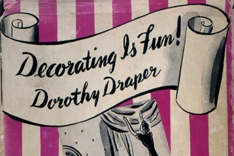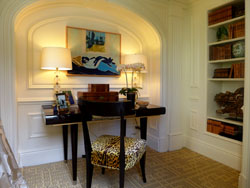Graphic Power: Geometrics
 Alexia Rossetti
Alexia Rossetti  Thursday, August 18, 2011 at 9:00AM
Thursday, August 18, 2011 at 9:00AM Is the sight of the same old solid colored wall getting you down? Does the prospect of picking out a print throw you into paralysis? Well, suffer no more! My series on Graphic Power is here to help you pick out a pattern.
There are many kinds of patterns out there but they can be categorized into just a few: floral, nature, animal, geometric, abstract, and scroll. In this issue, we’re going to concentrate on the graphic power of geometric prints.
 Persian rug from Central IranGeometric patterns are some of the oldest types of design, based on simple shapes of circles, squares, rectangles, and ellipses. Over the centuries, we have had endless variations of geometric patterns but a few have become quite distinct and popular. In Arab cultures, geometric patterns play an important role in design. Religion decreed that artwork can be limited only to geometric patterns and calligraphy as any figurative art was considered a form of idolatry and a sin against God. Consequently, incredible complex patterns arose from simple geometric forms as shown in ancient tribal rugs and mosaic tile work. Shown above is a Persian rug showing a diamond pattern with tribal motifs of varying geometric shapes. Persian rugs can be used in both traditional and contemporary homes as their small patterns complement most furniture styles.
Persian rug from Central IranGeometric patterns are some of the oldest types of design, based on simple shapes of circles, squares, rectangles, and ellipses. Over the centuries, we have had endless variations of geometric patterns but a few have become quite distinct and popular. In Arab cultures, geometric patterns play an important role in design. Religion decreed that artwork can be limited only to geometric patterns and calligraphy as any figurative art was considered a form of idolatry and a sin against God. Consequently, incredible complex patterns arose from simple geometric forms as shown in ancient tribal rugs and mosaic tile work. Shown above is a Persian rug showing a diamond pattern with tribal motifs of varying geometric shapes. Persian rugs can be used in both traditional and contemporary homes as their small patterns complement most furniture styles.
 Thom Filicia rug for Safavieh Current designers have re-interpreted Arabic patterns and translated it for modern homes. Designer Thom Filicia uses interlocking hexagon shapes for his contemporary take on Arabic styles. This simplified design, available from Safavieh, is perfect for the more minimalist decors.
Thom Filicia rug for Safavieh Current designers have re-interpreted Arabic patterns and translated it for modern homes. Designer Thom Filicia uses interlocking hexagon shapes for his contemporary take on Arabic styles. This simplified design, available from Safavieh, is perfect for the more minimalist decors.
The Art Deco style which originated from the 1920s also used many geometric patterns in its décor. The most popular included the waterfall, the ziggurat, fans, as well as the simpler forms of stylized triangles and diamonds. In the third photo of the slideshow above, we have an Art Deco-inspired wallpaper from Graham and Brown called Trapeze. Shown in a plum colorway, Trapeze uses elongated triangles and radiating suns for its pattern. Art Deco patterns are perfect for elegant, glamorous homes.
Midway through the 20th century, pop art became big and its bright and colorful parodies of cultural traditions influenced design in every field. The diamond lozenge pattern in mauves and grays called Helsinki as well as the orange curved diamond pattern called Trippy from Graham and Brown wallpaper collection (first two photos in slideshow) are inspired by this mod era.
 Thom Filicia rug for SafaviehAlso emerging from the mid-century era was the op-art movement. Optical art takes advantage of optical illusions, the interplay between illusion and the picture plane. M.C. Escher was a Dutch graphic artist who used optical illusions in many of his works. Pictured left is a rug designed by Thom Filicia for Safavieh which creates an optical illusion of stepped-up blocks when all there really exists in the whole composition are only two geometric shapes, a hexagon and a parallelogram in various orientations.
Thom Filicia rug for SafaviehAlso emerging from the mid-century era was the op-art movement. Optical art takes advantage of optical illusions, the interplay between illusion and the picture plane. M.C. Escher was a Dutch graphic artist who used optical illusions in many of his works. Pictured left is a rug designed by Thom Filicia for Safavieh which creates an optical illusion of stepped-up blocks when all there really exists in the whole composition are only two geometric shapes, a hexagon and a parallelogram in various orientations.
For those who desire a more subtle geometric design, we have simple geometric shapes in burnt orange and browns that are linked. Called the Hicks wallpaper from Graham and Brown (last photo in slideshow above), this elegant pattern would complement any contemporary home.
We've covered only the tip of the iceberg with these examples of geometric patterns. But as you can see in the variety, they evoke different moods from fun and wild to subtle and elegant to complex and ethnic. Next time you're looking for something dramatic or different, find a geometric print that fits the mood of your room.
Interested in learning more about fabric, wall and floor treatments? Take a look at Sheffield School's Complete Course in Interior Design. At Sheffield, you will learn how to transform a space, create color schemes, and select furniture, lighting, and accessories.



Reader Comments (17)
All the best
Artur
I really like Thom Filicia rug for Safavieh among your post.